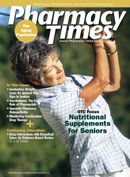Publication
Article
Pharmacy Times
Senior Health Watch
Studies Attribute Cause to Older Patients’ Falls
As patients get older, the risk of falls— and the complications that come with them—increases. In 2 separate studies, researchers attributed a bigger risk of falls in patients older than 70 to 2 factors—chronic pain and psychotropic medications.
In the first study, published in The Journal of the American Medical Association (November 25), researchers enrolled 749 adults over age 70. After a physical, they were monitored for 18 months to record the number of falls they experienced. The researchers found that older adults reporting chronic pain in 2 or more sites and those who reported severe pain or pain that impeded daily activities were 50% more likely to experience falls.
The second study, published November 23, 2009, in the Archives of Internal Medicine, examined the effects of 9 classes of drugs on patients aged ≥60. By analyzing 22 international observational studies from 1996 to 2007 investigating falls among those aged ≥60, researchers found that antidepressants were most associated with an increased risk of falls. Also connected with increased falls in older patients were antipsychotics/neuroleptics and benzodiazepines. According to the researchers, the greater risk from certain drugs could be attributed to higher sensitivity and slower metabolizing of the medications in older individuals.
“Spare Tire” in Women Drives Dementia Risk
Carrying excess abdominal weight has negative health connotations, but recent findings indicate that middle-aged women with a surplus of fat around their waists run a greater risk of dementia later in life. According to a study published in the November issue of Neurology, a high waist-to-hip ratio (WHR) in women during midlife can make them more than twice as likely to develop dementia in later years.
The study was based on the Prospective Population Study of Women in Sweden, which included data on 1462 women starting in 1968 when they were aged 38 to 60 years, and following them intermittently until 2000, using neuropsychiatric, anthropometric, clinical, and other measurements.
At the conclusion of the study, 161 women had developed dementia. The average age of diagnosis was 75. The researchers determined that middle-aged women with a WHR >.80 had slightly over twice the risk of developing dementia.
Older Alcohol Abusers Drink More
Although past research has shown that people tend to drink less alcohol as they age, a recent study proved the opposite for older individuals with drinking problems. Individuals older than 60 with an addiction to alcohol drink more than their younger counterparts—an average of more than 40 alcoholic beverages per week, compared with 25 to 35 consumed by younger people with drinking problems, according to the researchers from Ohio State University. In addition, older problem drinkers reported more binge drinking incidents per month than younger ones.
The higher consumption is likely related to a higher tolerance developed from years of alcohol abuse. Such drinking is especially of concern for older patients, as it presents a greater threat when combined with the physiological effects of aging, according to the study’s authors.
Older Men Who Lose Their Wives More Likely to Gain an STD
Evidence is showing that life does not stop for older men after their wives die—unfortunately, nor does their chance of contracting a sexually transmitted disease (STD). Recent elderly widowers are more likely to be diagnosed with an STD compared with their married counterparts, according to a study published in the American Journal of Public Health (November). The introduction of erectile dysfunction (ED) drugs has only seemed to make matters worse for newly widowed sexually active senior men.
In the study, began in 1993, the researchers determined that men had a 16% higher chance of becoming infected with an STD from 6 months to 1 year after losing their wives. After the first ED drug was introduced in 1998—despite statements from the manufacturer warning that it does not provide STD protection—the widowers’ probability of being diagnosed with an STD jumped to 83%.
It is important to note that, of 400,000 US couples monitored for the study, the number diagnosed with an STD was less than 1%; however, the authors stressed the importance of men especially being aware of their risks, particularly those who are again becoming sexually active with the use of ED drugs. â–
FAST FACT: The population of individuals aged ≥65 is slated to increase by 40% over the next 5 years, as life expectancies are increasing due to better health.







